.jpg)
Installation view, Donald Rodney: Visceral Canker, Spike Island, Bristol, 2024. Photo: Lisa Whiting.
Spike Island, Bristol
25 May – 8 September 2024
by TOM DENMAN
From the mid-1980s until sickle cell anaemia took his life in 1998, Donald Rodney was an artist who engaged with the broad social repercussions of his hereditary illness. In and out of hospital and often needing a wheelchair to get around, he was at odds with the widespread, reductive representation of the Black man as athletic (which in turn sustained the perception of the Black man as intellectually deficient). Art, as Rodney explains in Black Audio Film Collective’s ode to the artist, Three Songs on Pain, Time and Light (1995), provided a community where he felt accepted. It is apt to consider Rodney’s relevance today, not least since “care” has become something of a buzzword in contemporary art, denoting, among other things, the curation of safe, empathic environments. This retrospective provides a welcome opportunity to do this.
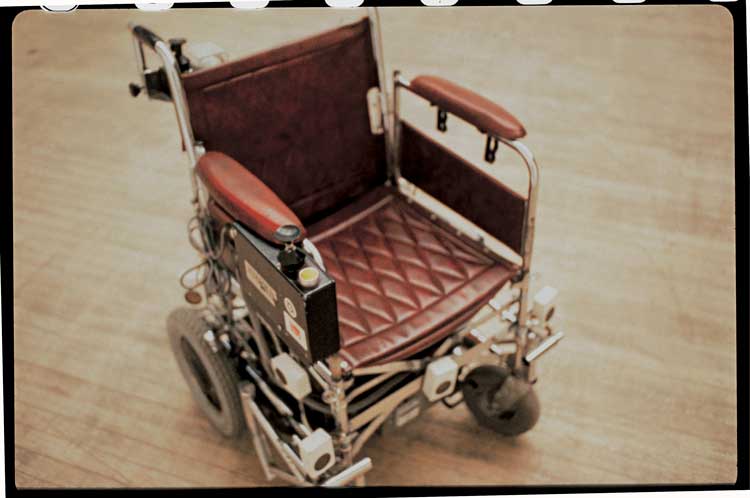
Donald Rodney, Psalms, 1997. Motorised wheelchair, computer, proximity sensors. Courtesy the Estate of Donald Rodney and Tate.
A wheelchair, rigged with an automated motor, scurries about the gallery of its own accord. Psalms (1997) originally stood in for Rodney at the opening of his solo show at South London Gallery in 1997, which he was too sick to attend. It is a bittersweet self-portrait that insists on the absence of its subject, first in illness, then in death, its path interweaving his lived experience of illness with its social symbology, physical impairment with spiritual animation. We can speak to Rodney via Autoicon (1997-2000), a conversational archive, recorded on a CD-ROM, that he began, and his friends finished. I typed in “What are you doing today?” and the word “doing” – a positive, action word – yielded an audio recording of his voice saying: “Definitely!” It would be wrongheaded to think that such automative works directly foreshadow artificial intelligence or billionaires computerising their brains. For Rodney, in these works at least, instead of productivity or ego, the primary motivation is love. If the works feel prescient, it is because today they remind us of an alternative, affective model – not one in which technology replaces the person, but one in which technological art preserves their memory.
These works, alongside Black Audio Film Collective’s film, add a heartfelt commemorative tone to an exhibition that mainly deals with bleaker realities – and in which Rodney’s voice is vivaciously critical. He equated his sickness with society’s sickness, manifesting especially in the persistently pernicious intersection of racism and ableism. In a work that blurs the distinction between metaphor and causal relation, Visceral Canker (1990) pumps blood through tubes that circulate the coats of arms of the 16th-century slave trader Sir John Hawkins and his glorified English queen, aligning Rodney’s own sanguinary disease – and the racial biases that infiltrate healthcare, not least in relation to sickle cell anaemia, stigmatised in no small part because an exceptionally high percentage of people of African descent have it – with a lineage of state-sanctioned violence against Black bodies.
.jpg)
Donald Rodney. Pygmalion, 1997. Installation view, Donald Rodney: Visceral Canker, Spike Island, Bristol, 2024. Photo: Lisa Whiting.
Pygmalion (1997), its title referring to a myth in which someone is shaped according to someone else’s desires, is an uncanny fairground automaton of Michael Jackson in blackface, painted over his surgically whitened skin. Performing on cue – a motion sensor sets him off when we come close – the pop legend’s robot dance is in tune with his mechanised (we might also say medicated) social imprisonment.
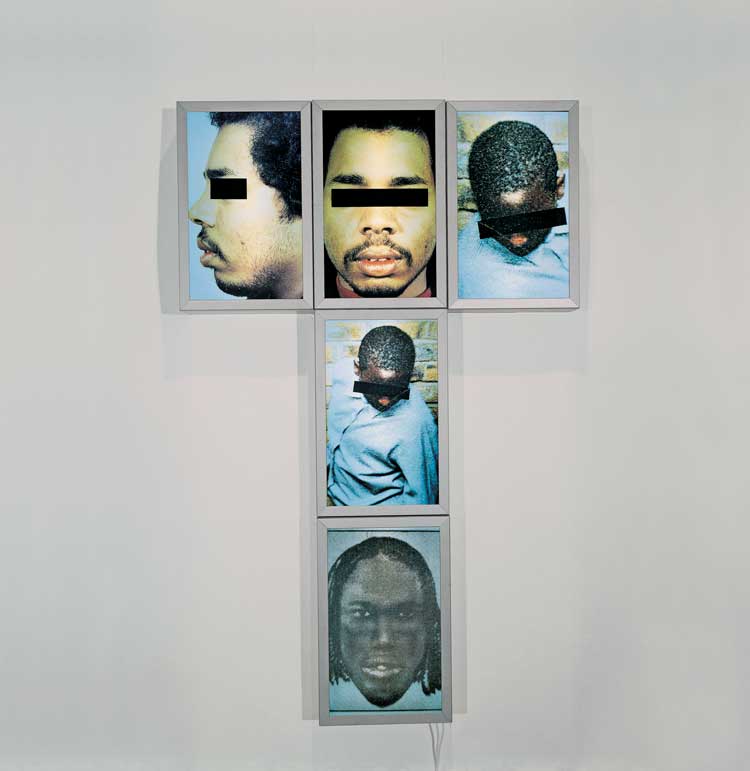
Donald Rodney. Self Portrait: Black Men Public Enemy, 1990. Lightboxes with Duratran prints. Installation view, Donald Rodney: Visceral Canker, Spike Island, Bristol, 2024. Photo: Lisa Whiting.
Rodney’s composite Self-Portrait “Black Men Public Enemy” (1990) arranges on a T-shaped, cruciform lightbox images of Black stereotypes – an identikit face, a man in handcuffs – and an image of another man with sickle cell anaemia (pointedly not Rodney), to observe the generalised inscription of identity on the Black, sick body from without. Cataract (1991) is an automated slide projection showing fragments of faces of different Black men – this time including Rodney – the collaged parts clicking in and out of view. As forms of display, the slideshow and the lightbox are suggestive of policing. These works consider a situation exacerbated by the biases of today’s facial recognition technology and AI – also based on composites – not only in the law, but in everyday administrative and personal use.
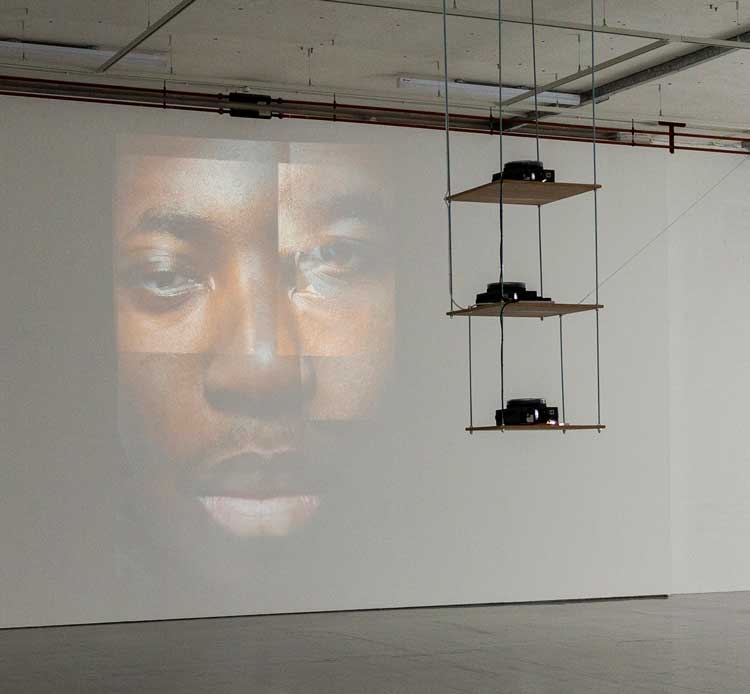
Donald Rodney. Cataract, 1991. Installation view, Donald Rodney: Visceral Canker, Spike Island, Bristol, 2024. Photo: Lisa Whiting.
Rodney often salvaged X-rays as a material, the multilayered metaphor calling for a more penetrative look at society, while fusing his physical pain with the societal and ancestral pain of Black suffering. The House that Jack Built (1987) is formed of X-rays, mostly of someone’s thorax, before which sits a man’s raggedy clothing impaled by a black, blasted tree – which is also the man. The ensemble suggests a Hadean sentence of being lynched by lineage.
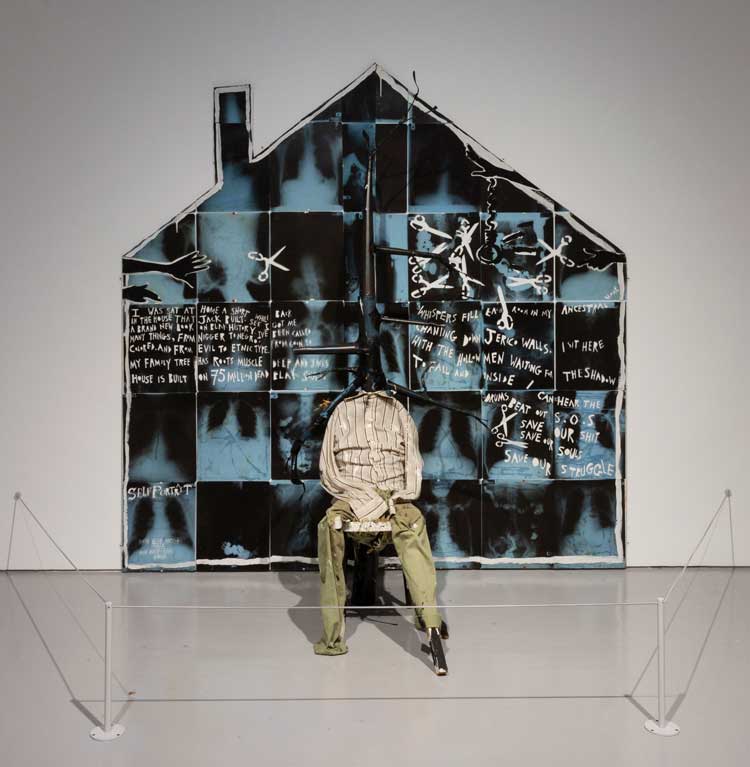
Donald Rodney. The House that Jack Built, 1987. Mixed media. Installation view, Donald Rodney: Visceral Canker, Spike Island, Bristol, 2024. Photo: Lisa Whiting.
Britannia Hospital 2 and 3 (both 1988) are paintings of racial anguish applied straight on to a patchwork of X-rays. In the latter, the disabled artist and antiracist campaigner Frida Kahlo’s self-portrait in a body brace, The Broken Column (1944), appears alongside a Black figure undergoing surgery, while lurking in the background is a member of the Special Patrol Group, the notoriously violent branch of the Metropolitan Police.
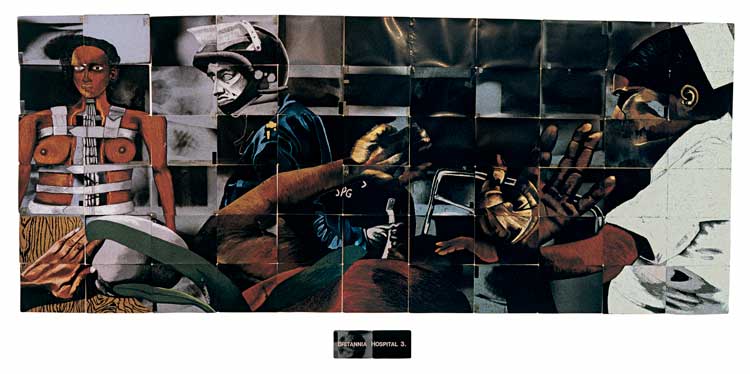
Donald Rodney. Britannia Hospital 3, 1988. Oil pastel on x-ray. Installation view, Donald Rodney: Visceral Canker, Spike Island, Bristol, 2024. Photo: Lisa Whiting.
The title Britannia Hospital derives from Lindsay Anderson’s 1982 film mocking the UK’s National Health Service, and the paintings point to ingrained racist attitudes that the film makes light of and – judging by ongoing complaints of institutional racism in the NHS, not to mention unquestionably racist remarks earlier this year about the MP Diane Abbott by Frank Hester, one of its clinical technology suppliers – remain unresolved.
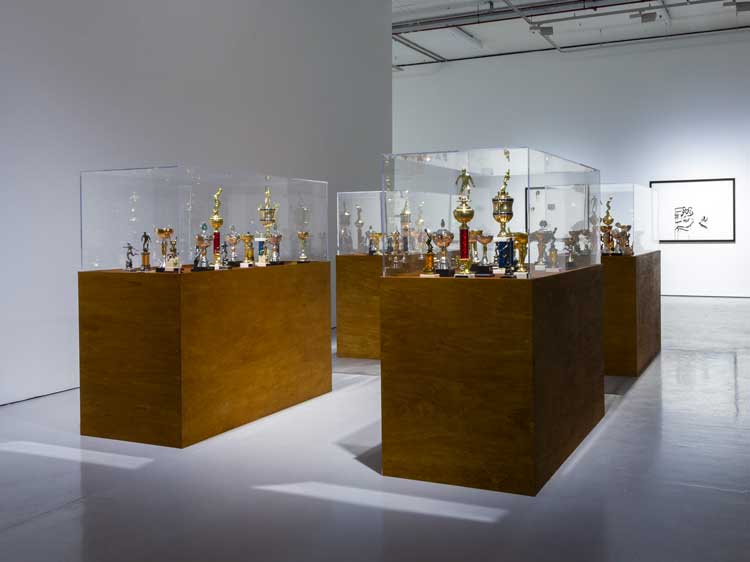
Donald Rodney. Doublethink, 1992. Installation view, Donald Rodney: Visceral Canker, Spike Island, Bristol, 2024. Photo: Lisa Whiting.
Rodney’s wheelchair guided me to four large vitrines displaying Doublethink (1992), a collection of sports trophies to which are affixed labels that mimic racist hearsay, including phrases such as “BLACK CRIMINALITY IS GENETIC”, “BLACK PEOPLE HAVE POOR INTELLECT” and “BLACK WOMEN ARE SLY AND SCHEMING”. The issue of disingenuous, “doublethinking” praise, and the lack of trust this must inspire, is still very much alive. One might be reminded of Euro 2020 (postponed to 2021, due to the pandemic), when Black football players were praised by fans for steering the English national team to the final, only to receive torrents of racist abuse after England’s defeat against Italy. The average art gallery visitor is unlikely to identify as a football hooligan, let alone a racist one, but it would be wrong to say that the gushing, self-vindicating oohing and aahing for which the art world is known – especially when directed at artists of colour when it is politically and economically expedient to do so – does not raise suspicion.
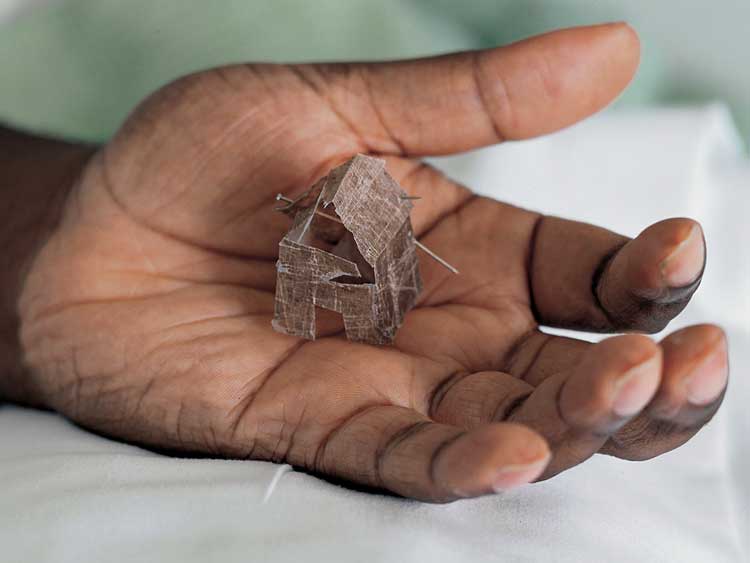
Donald Rodney, In The House of My Father, 1997. Photograph. Courtesy the Estate of Donald Rodney and the Arts Council. Collection.
Much of Rodney’s work is physically fragile, and some of the examples recorded in the archival presentation no longer survive, or are lost, such as his commemorative frieze, Soweto/Guernica (1988). His Land of Milk and Honey II (1997) was to be included in this exhibition before it was found to be damaged. This fragility is achingly resonant – perhaps most of all in My Mother. My Father. My Sister. My Brother, a minute house made from the artist’s own skin (containing, perhaps, his defective haemoglobin gene), placed beside a photograph of it resting in the artist’s palm, In the House of My Father (both 1996-97). Is art really less transient than life? That Rodney’s work isn’t slick, that it doesn’t scream market value, may have partly resulted from a lack of monetary means, but its resonance with the artist’s own unslick body is nevertheless a thunderbolt to the heart. And in its rawness of affect and creativity is a critique all the more relevant today, one that subverts contemporary life’s unhealthy obsession with productivity and polish.